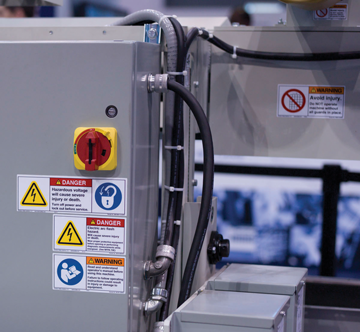In this column, we’ll explore how the safety labels you use on your products should function as a system in order to most effectively improve safety and reduce liability.
As a professional in the electrical engineering field, on a daily basis you’re likely striving to stay up-to-date on the latest news and insight related to EMC, product safety, and designing for compliance and regulatory updates. That’s no easy task. When it comes to communicating safety, you understand the importance of the safety labels and markings for the products you design or manufacture. Yet this is just one part of your work and areas of responsibility, and as such, you may be looking at your labeling singularly – not as a part of a larger picture of safety. I’d like to introduce to you a concept, a different perspective on safety messaging: Look at your product safety labels as a system, specifically a safety communication system.
We typically don’t think about safety signs as anything more than a sign on a wall or a product. So, what exactly do I mean by seeing your safety labels as a system? Actually there are three different “systems” at work here:
First, the label (if it’s a best practice label based on the latest standards) is a system in and of itself. It’s made up of a variety of standardized and tailored elements (color, text, borders, shape, size, and graphical symbols) that are designed to work together to effectively communicate the intended safety message to the intended audience. (See Figure 1.)

Figure 1: Best practice safety labels communicate complete hazard information – using components like color, text, and symbols that all work together as a system. (Label design ©Clarion Safety Systems.)
Second, each of your safety signs and labels works within a larger system:
- For product safety labels, this “system” is the product itself and all of the other safety labels you may be placing on it.
- For facilities and public environments, the “system” is the context in which each sign is placed and all of the other safety signs you have installed in the location.
For example, a product safety label on a machine near a potential hazard, such as an electrical hazard that could exist if someone needs to service an electrical panel, may refer the viewer to another safety label that details a lockout/tagout procedure. (See Figure 1). Both labels reinforce each other and work as a “system” to convey important safety information.
Another example would be to place a multi-hazard warning label on the machine’s control station, and then to place the specific hazard alerting safety label on the machine at the potential point of interaction with the hazard. Again, the two labels work together to reinforce and remind people of potential hazards.
A third example of a systematic way to present safety messages is to use a “Read and understand manual” safety label on the machine, putting the viewer on notice that they should read the machine’s operation and/or maintenance manual so they are fully aware of the manual’s detailed instructions and precautions so they avoid injury when operating or maintaining the equipment. (See Figure 2). The value of combining the placement of a “read manual” safety label on a machine with a well-written set of instructions that has accurate, embedded safety messages cannot be overstated. I lecture at the University of Wisconsin’s Engineering Department’s professional development course on warnings and instructions twice a year on this topic and over the last decade, we’ve seen this practice implemented successfully many, many times. Both accidents are reduced and lawsuits are dismissed because “adequate warnings” were given, both on the equipment and in the equipment’s manual.

Figure 2: Safety labels can reinforce one another, and reinforce critical safety messages, with consistent communication and best-practice, uniform design principles. (Label designs ©Clarion Safety Systems).
The third way your labels and signs can work as a “system” has global implications. By using the latest best-practice ANSI and ISO standards to format and communicate your safety messages, you’ll be joining the effort to implement a global system for communicating safety information. Consistency is the key here. Using the design principles and graphical symbols that appear in the principle standards having to do with safety signage will include you in this “system.” The theory behind standardization in this field is that through the consistent visual presentation of safety information, greater recognition and understanding of safety messages will occur. With greater understanding comes less confusion, better decisions, and fewer accidents. This is an important concept and it’s the reason why I dedicate so much time to my work on the ANSI and ISO standards committees. With the implementation of these best-practice standards-based systems on your products and in your facilities, the lives of people now and long into the future will be better protected from harm.
When you recognize that your safety signs and labels are not just solitary messages but belong to a wider system of safety communication, you can literally participate in having a positive impact on the world. So when it comes to developing the labels that are going to appear on your products and the signs that go in your facilities, ask yourself these questions:
- Does each of your signs and labels use the right system of standardized and/or tailored components to most effectively communicate the safety message at hand?
- Do they fit within the larger system of safety information (other safety signs, labels and markings) that are present on your product or posted in your facility?
- And do they use the proper international system of formatting and graphical symbols that’s been established by the latest global standards – standards that are establishing a worldwide safety language meant to protect people from harm?
Saving lives…. there’s no greater reward for our efforts.
For more information about safety signs and symbols, visit www.clarionsafety.com. ![]()
 |
Geoffrey Peckham is CEO of Clarion Safety Systems and chair of both the ANSI Z535 Committee and the U.S. Technical Advisory Group to ISO Technical Committee 145- Graphical Symbols. Over the past two decades he has played a pivotal role in the harmonization of U.S. and international standards dealing with safety signs, colors, formats and symbols. This article is courtesy of Clarion Safety Systems ©2012. All rights reserved. |
